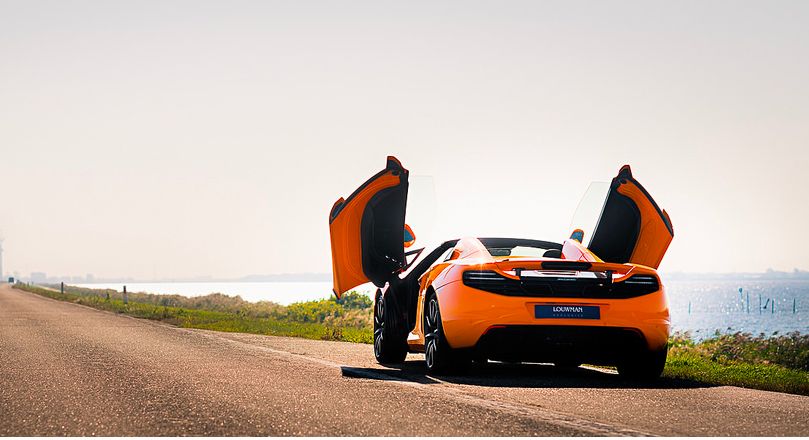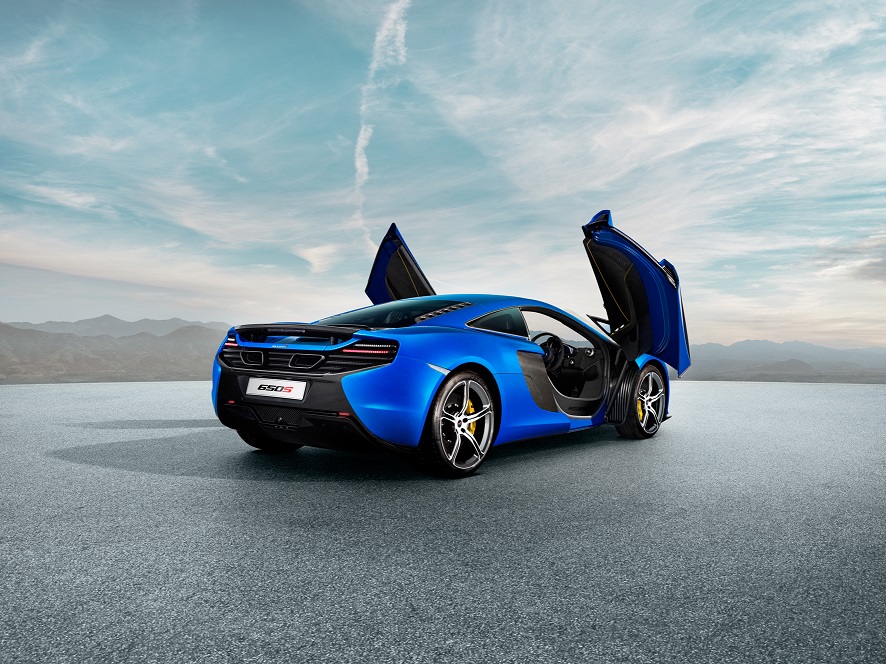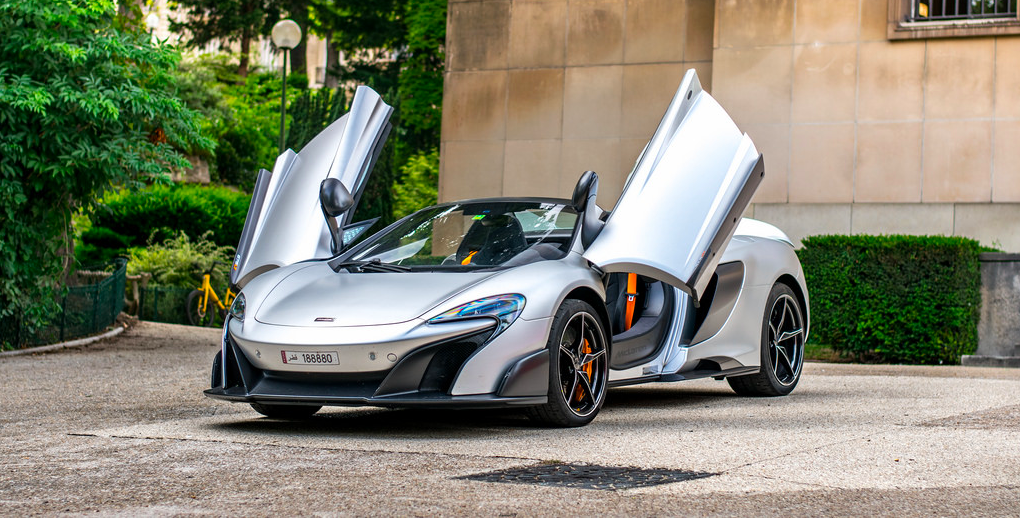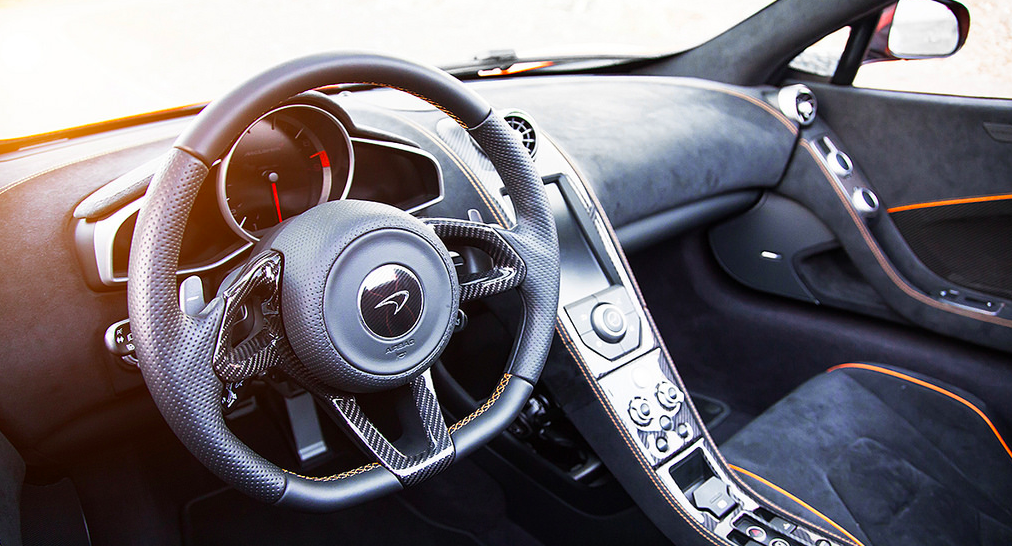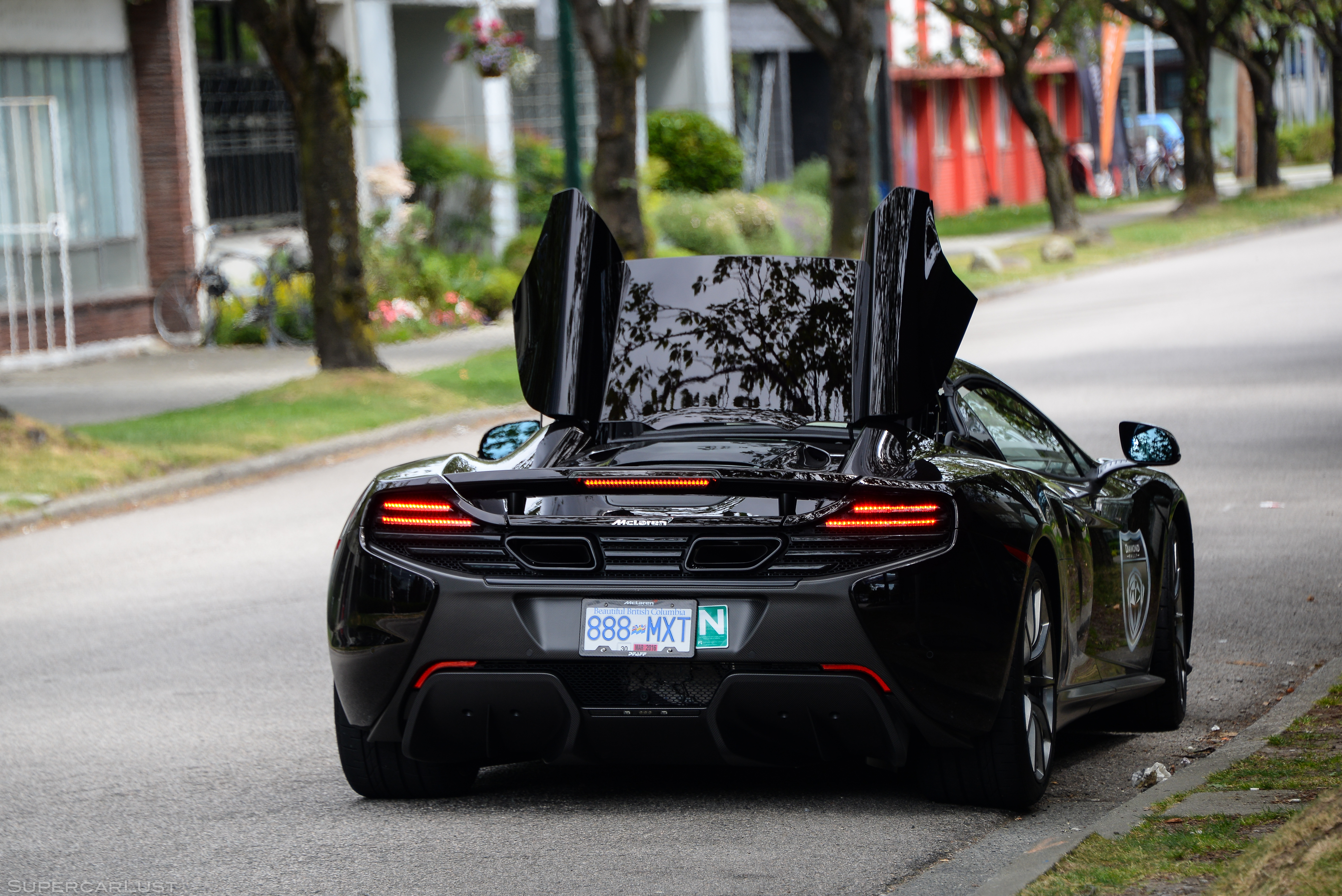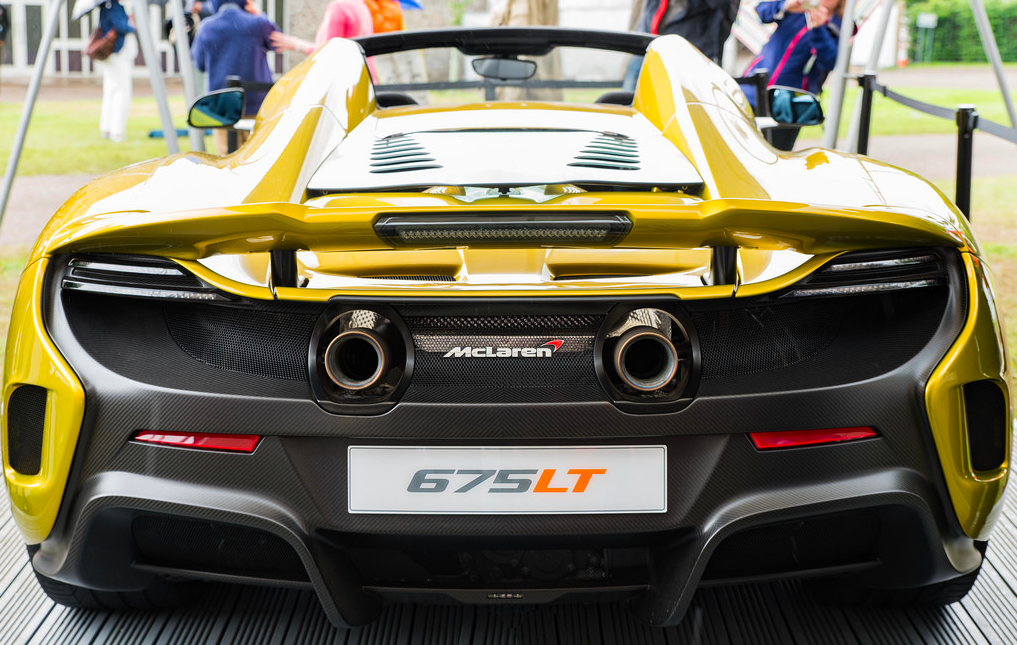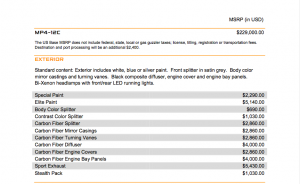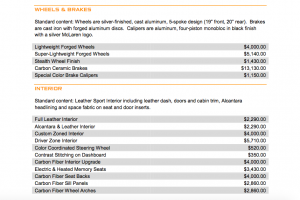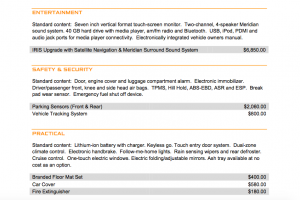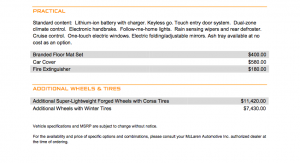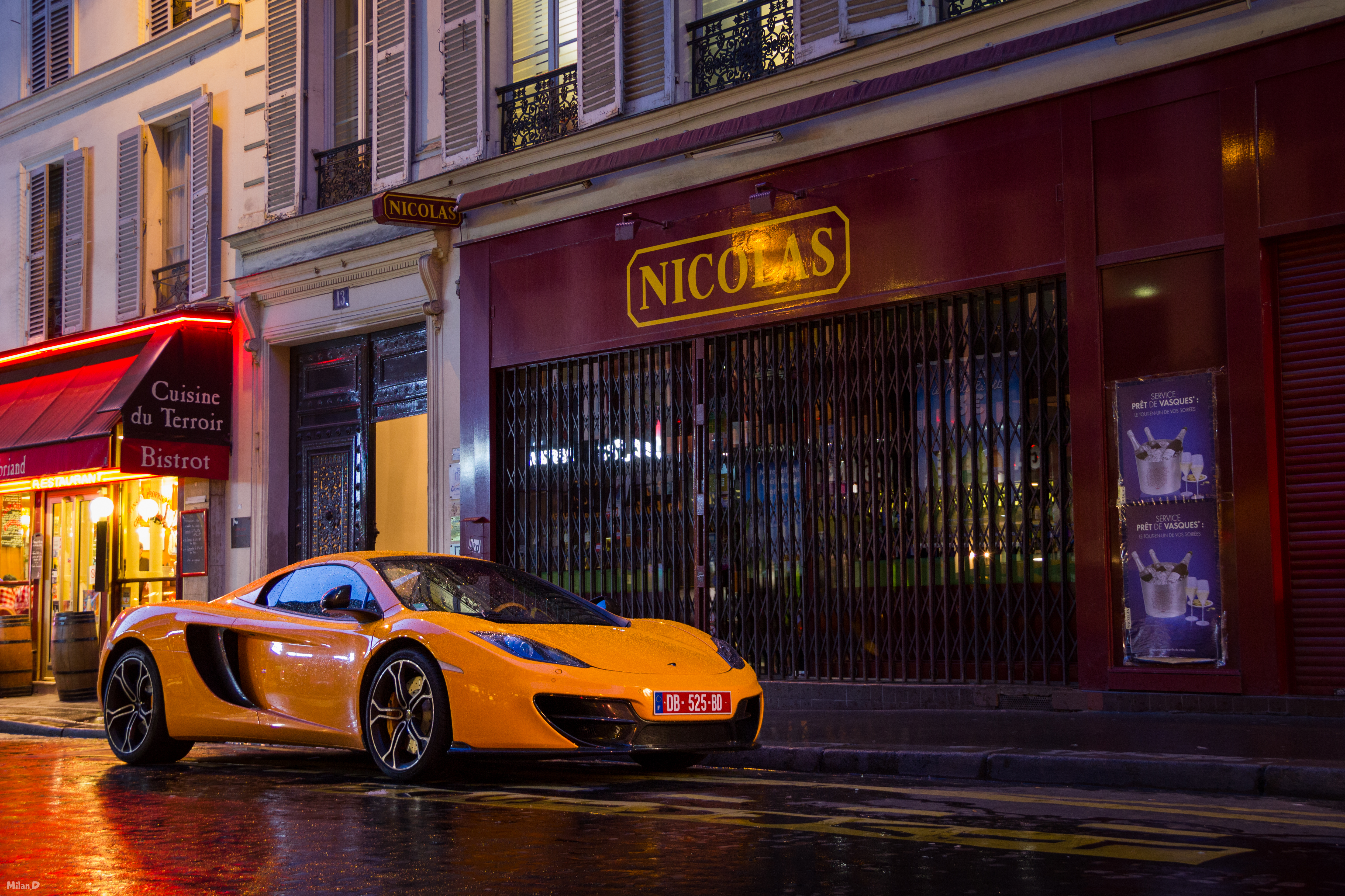A blast from the past meets a visit from the future. McLaren Automotive has been around since 1963, changing the Italians favor for sports and luxury cars, making them in house the British way. Beginning with race cars for Formula One racing, McLaren soon jumped into the Exotic/Super Car game with it’s MP4-12C.
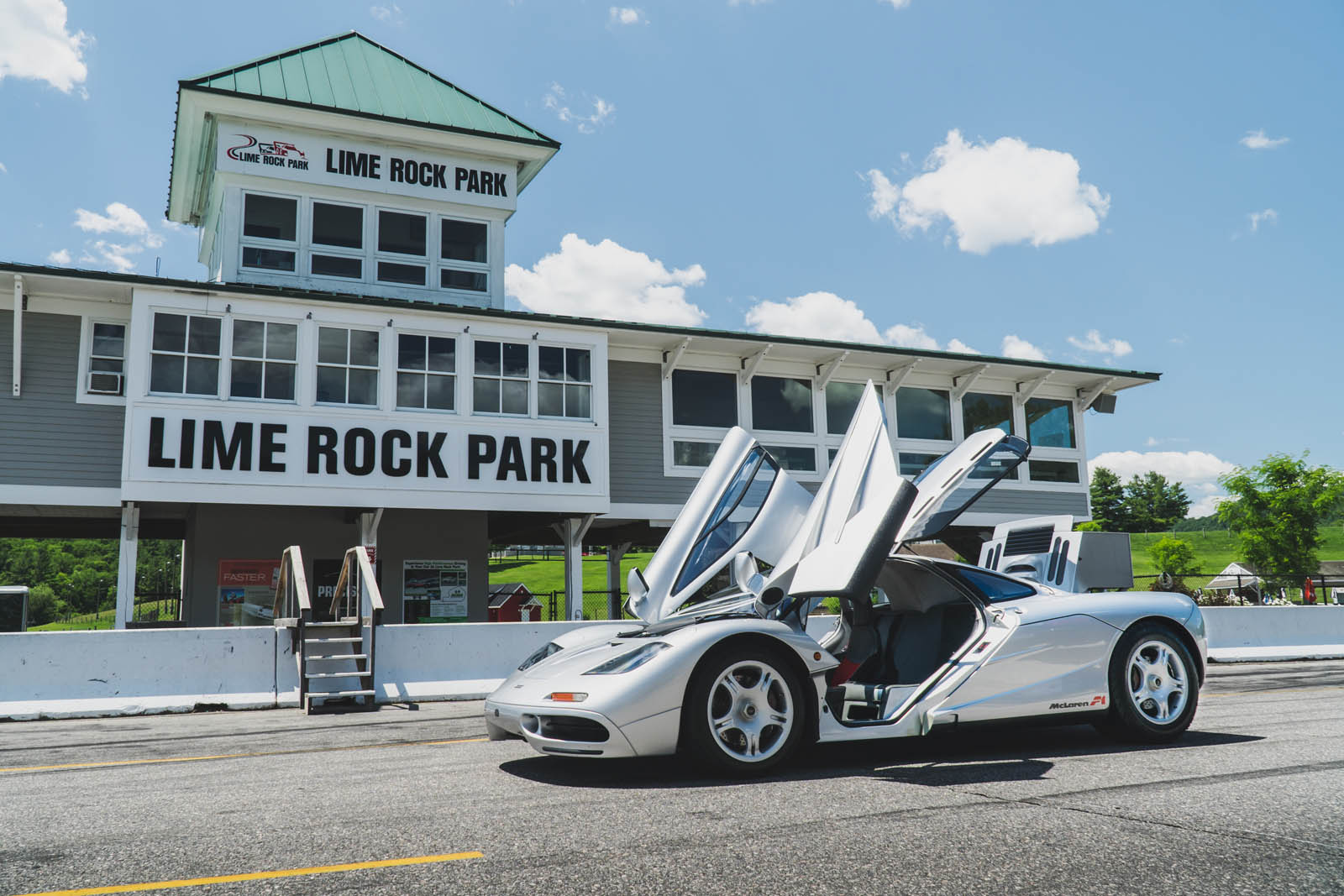 With the finished product unveiled early on in 2009, the first models weren’t released until mid-2011, making the 2012 McLaren MP4-12C the first production car designed and built fully by McLaren since the first ever carbon fiber road car, the 1993 McLaren F1. The F1 broke world records, reaching top speeds of 240.1 mph, only to be beat by the Bugatti Veyron in 2005. Sadly, the racing machines reign of domination ended in 1998, and since then, McLaren laid waiting for it’s next break out beast.
With the finished product unveiled early on in 2009, the first models weren’t released until mid-2011, making the 2012 McLaren MP4-12C the first production car designed and built fully by McLaren since the first ever carbon fiber road car, the 1993 McLaren F1. The F1 broke world records, reaching top speeds of 240.1 mph, only to be beat by the Bugatti Veyron in 2005. Sadly, the racing machines reign of domination ended in 1998, and since then, McLaren laid waiting for it’s next break out beast.
With such success in the MP4 design and build, more evolutions came to the streets. Two more powerful space ships came about: the McLaren 650S and the McLaren 675LT, a trifecta of raw power. All built with the same futuristic body style, mechanical tone, and butterfly doors that open up and out. McLaren sure did create an absolutely jaw dropping and puzzling car. Many don’t understand exactly what these cars are and what they are capable of doing, but those who do, use it’s powers for good and evil.
The MP4-12C is build as a rear wheel drive, mid-body 3.8 liter twin turbo V-8 engine, which has the ability of producing 592 horsepower with 443 pounds of torque. With all that capacity and the weight of 3,161 pounds (thanks to the full carbon fiber tub),the MP4 is given a top speed of 218mph. The electronic transmission connected to the engine is a seven speed automatic dual clutch gearbox, with the ability to be put into overdrive and automatic manual controlled by tiptronic paddles located behind the steering wheel.
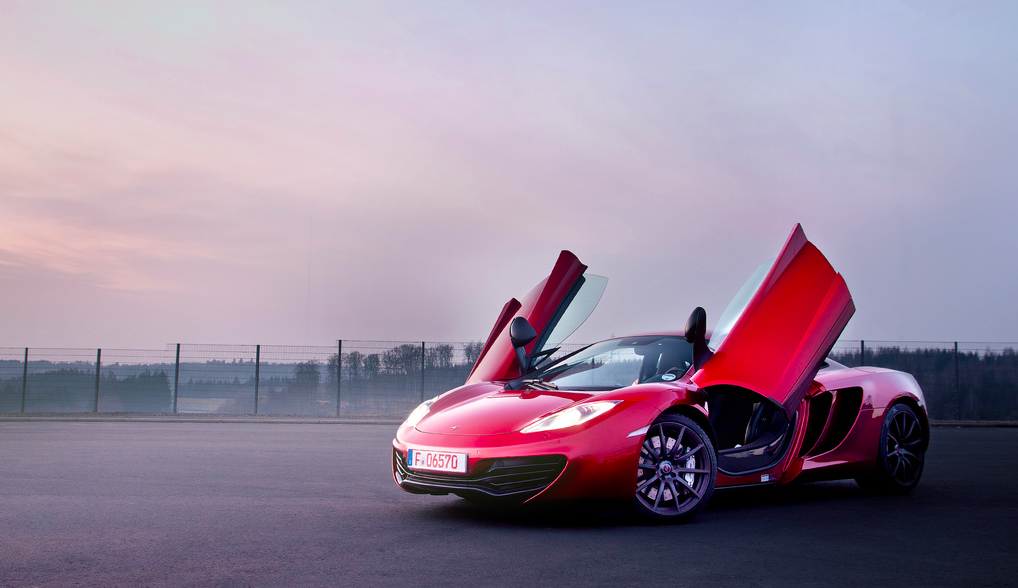 Even with all this power McLaren set out to create a super car that was also usable for a daily driver. One of the helpful advancements made in the daily driving direction was keep fuel emissions low. The MP4-12C emits low amounts of carbon-dioxide and has a better fuel economy than most of it’s rival supercars with 15mpg (city)/ 22mpg (highway).
Even with all this power McLaren set out to create a super car that was also usable for a daily driver. One of the helpful advancements made in the daily driving direction was keep fuel emissions low. The MP4-12C emits low amounts of carbon-dioxide and has a better fuel economy than most of it’s rival supercars with 15mpg (city)/ 22mpg (highway).
A car built a head of its time but with a less flashy “look-at-me” kind of attitude, the McLaren MP4 (along with the rest of it’s production family) has a tendency to make people look twice and ask “what is that?!”. The body of the McLaren is narrow, not letting any space go to waste. The aerodynamics of the McLaren are revolutionary by design. The front of the MP4 sits low, giving you a look with it’s fully automatic, auto-leveling, LED headlights, forged in the shape of the McLaren logo which represents a streamlined speed-mark which is said to bare similarities with the vortices created by the rear wing. The cargo compartment sits at the front, making it another supercar to cary the “frunk” style, also graced with another McLaren logo. But with space for nothing bigger than a few bags of groceries, don’t try and make this your caravan car. Underneath is where you first get a sense for the supercar ability. Air intakes line the front bumper, slotted just a total of three times allowing for maximum air flow to help cool the twin turbo engine. The windshield higher sitting along with broad and angular to allow the driver to see up and out over what ever roads the MP4 is deciding to dominate.
Along the sides, the McLaren’s design really seems to take it’s shape. A low flow and massive downforce is given to the car by pulling the design of 19 inch 5 spoke aluminum alloy wheels in the front and 20 inch matching designed wheels in the rear. The lines from the front flow seamlessly throughout the long body of the MP4, curving up and around to make the hinge opening for the beautiful butterfly doors that lift up and out taking the side mirrors with them. Though the doors are probably one of the coolest things about this car, they are also the most tricky. There is no button, toggle, or lever to open the door. It is controlled only by a small sensor in the handle located towards the back and opening of the door itself, you’ve got to hit it just right otherwise, you’re left in the cold. Behind sits a dual slated air intake that pushes into the body of the car and hidden by the side panels. The two curves continue on down through the rear quarter panels of the McLaren, giving it a aesthetic appeal of being as aerodynamic as it really is.
The rear of the MP4 houses the most intriguing components of the car. Up top is where you can see just for yourself the power the McLaren holds through the rear window that lets you take a peak into the engine bay. Followed soon after by the innovation of the airbrake, that was created thanks to McLaren’s Brake Steer. Banned on the track in 1997 after being used on the McLaren Formula One, the airbrake was gifted to the MP4-12C upon creation. While giving a massive performance advantage out on the track, the airbrake also helps to prevent wheel spin and improve traction. The adjustable airbrake sits on a smart hydraulic piston that deploys the airbrake at top speeds when braking to help increase downforce and moves the center of pressure towards the rear. This mechanism helps protect the driver if they were to enter a corner to quickly or aid a driver that wanted to find the quickest entry and exit into a turn on the track while avoiding understeer and a possible spin-out and collision. Underneath the airbrake sits the LED taillights and more air intakes that share the same design as the front. Smack in the middle of the air intakes sit the dual exhaust pipes that bare an angular shape and emit the perfected forced induction European V8 tone that truly is music to any car enthusiasts ears.
The evolution of the MP4-12C into the 650S didn’t come without some body modifications. The headlights take on the P1 design of the total speed-mark logo shape. P1 influence is also carried down into the front bumper with fully open frontal bar to give more room for the air intakes, sitting lower than on the MP4-12C. The side air-intakes are no longer the double blade design from the MP4, but are now singles that blend into the body line.
On to the 675LT, still the basis of the MP4 was used, but now with a few more track friendly evolutions now. The 675LT was designed strictly to be the top performance car out of it’s brethren. Coming with an extended wheelbase, the aerodynamics are only further heightened. Anything that can be carbon fiber is now carbon fiber to help reduce weight even more, including everything from the extended front splitter to the extended side air intakes. Perhaps the most noticeable upgrade is the 50% larger carbon fiber AirBrake that helped brand the 675 “LongTail” LT. The 675LT is far from shy in showcasing just how fast it is.
A car that is truly a head of it’s time yet still manages to drop jaws even years after it’s creation. With a body meant to be narrow, compact, and all about downforce, the beast achieved everything it was designed for. McLaren’s goals were met with the MP4, creating a timeless design along with reducing weight exponentially. While many say the car is to compete with Ferrari 458’s the aesthetic appeal of he McLaren MP4-12C is in a class all of it’s own.
Driving Experience
Though the MP4 seems like a spaceship that only the throughly trained could ever hope to pilot, it is quite the opposite. McLaren wanted to make the MP4 that was something anyone and everyone could drive on the track, highways, and local roads. We already know the AirBrake technology is extremely helpful when whipping the McLaren around the track, but the components that make it a daily driver are still just as interesting. The front and rear suspension are both independent double wishbone shape.At the front you find the mounted steering rack and coil-over shock absorbers all made of aluminum. The MP4 is without a front stabilizing bar, though. What it is fitted with instead is a complex set of tubes that connect and help electronically control the weight distribution of the car in and out of turns. The MP4-12C was designed on a rack-piston steering basis to avoid the extra weight a normal hydraulic power steering would bring about. But with bad comes good and the hydraulic steering is a superior feeling to rack-piston, so McLaren designed to make the best of both words. Fitted with a electric-driven hydraulic pump that drives power into the rack through short lines they were able to make two worlds collide into one ultimate driving machine.
With the Airbrake proudly displayed at the back of the MP4, we shouldn’t soon forget about the brakes that really make it count. Held in by 4 piston calipers and two-piece aluminum rotors, the brakes are there to help you stop on a dime, with or without its power controlled counterpart in the back. For an upgrade of $13,000 you can fit the MP4 with top of the line 6 piston fixed calipers and cross-drilled carbon ceramic brakes that even feature a brake-cooling duct to ensure optimal performance.
With so many technological enhancements to the MP4, one may think that the car could simply drive itself, but this is not what McLaren wants. From a history of racers, McLaren wants the driver to have more control over the car than the car has of it, that’s why it is outfitted with so many enhancements. For example, the driver doesn’t even have to think twice about a spin-out on a tight turn because the Airbrake will deploy and help stabilize the MP4 before it even has time to think of crashing.
After leaning low and slow into the McLaren MP4-12C and sitting behind the wheel the driver is automatically underwhelmed, but that is necessarily negative. The cabin design is sleek and simple. The all leather sport interior covers the dash, doors, and trim of the cabin. The space fabric seats are not full on racing style either, so they are surprisingly comfortable. Behind the wheel you first get the feel for you tiptronic paddle shifters and then there is the trifold LCD dash that gives readings of odometer, trip mile counter, temperature, and time on the left. With the massive circular center being kept for the RPM gauge and speedometer. To the right you get your fuel, water, and oil readings as well as a Handling and Powertrain mode so you can see just how you have the MP4 driving. To the center is your control panel. The standard seven inch LCD display gives the driver control of everything from radio, bluetooth, navigation, apps, internet, and so much more that is really more suited for a cruiser than your average super car, but why not have it all?
Below sits the magic push to start button we all know and love.
Underneath sits the active Dynamics Panel. To activate the panel one must hit the “ACTIVE” button first and wait for the dials to illuminate to show it’s working.The left toggle is marked “H” for Handling will change the pressure in the hydraulic system and has the Normal, Sport, and Track mode options. As well as the right toggle which is marked “P” for Powertrain will control throttle response, gear-change speed, and opens the hydraulic exhaust system.
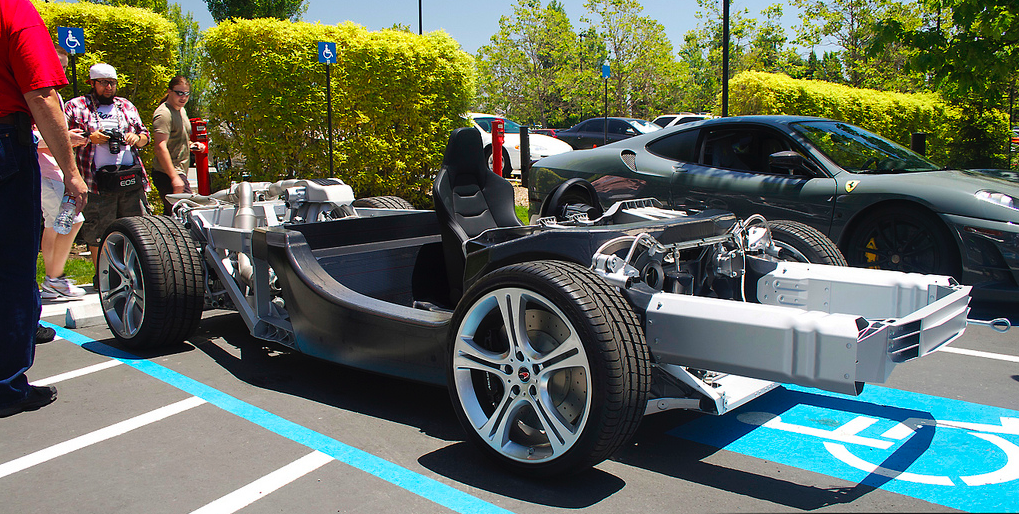 From Normal to Sport you will get a tightened suspension, but not too noticeable to where the car becomes too tight to drive (remember, no sway bars!), as well as a deeper and more powerful exhaust note. Sport to Track the car tightens almost instinctively, as if you let a lion out of its cage in the zoo, with a full open exhaust and the need for speed.
From Normal to Sport you will get a tightened suspension, but not too noticeable to where the car becomes too tight to drive (remember, no sway bars!), as well as a deeper and more powerful exhaust note. Sport to Track the car tightens almost instinctively, as if you let a lion out of its cage in the zoo, with a full open exhaust and the need for speed.
Inside the two toggles sit “Aero” which is the control for the automatic AirBrake to be either permanently kept at it’s 32 degree angle, or to have the ability to exercise it’s movement. “Manual” is exactly what it sounds like, when engaged you have the car literally in the palm of your hands with the tiptronic paddle shifters, when out of manual mode it becomes an automatic car.
Final two buttons are two mode controls: on the right is everyones favorite: LAUNCH. By separating the two clutches, applying the brake firmly to the floor, allowing the throttle to climb and then releasing the brake, the MP4 will literally fly down the road with full power. WINTER mode is next and it will reduce the horsepower to a flat 500hp and doesn’t allow the car past third gear to keep traction control high and tight on slippery roads. Then under those you have window and climate controls for the vehicle. No cupholders found on this center console, so keep the coffee to a minimum. The only place to put your drinks is a small fabric fold on the passenger side.
Two seats is all you get with no possible option of a back seat, so choose your passengers wisely. But no matter who is by your side or driving you around, you will find comfort in this beast and it’s brethren. The unique and independent suspensions allow for a smooth ride. The shape and aerodynamics of the car allow you to flow with the wind and not have the cabin flooded with annoying wind pressure from every angle. With the driver able to choose just how they want the MP4 to run, wether it be on the highway to work, the empty back roads to scare/excite the passenger with launch control, or on the track leaving everyone behind, the MP4 is the ultimate driving experience.
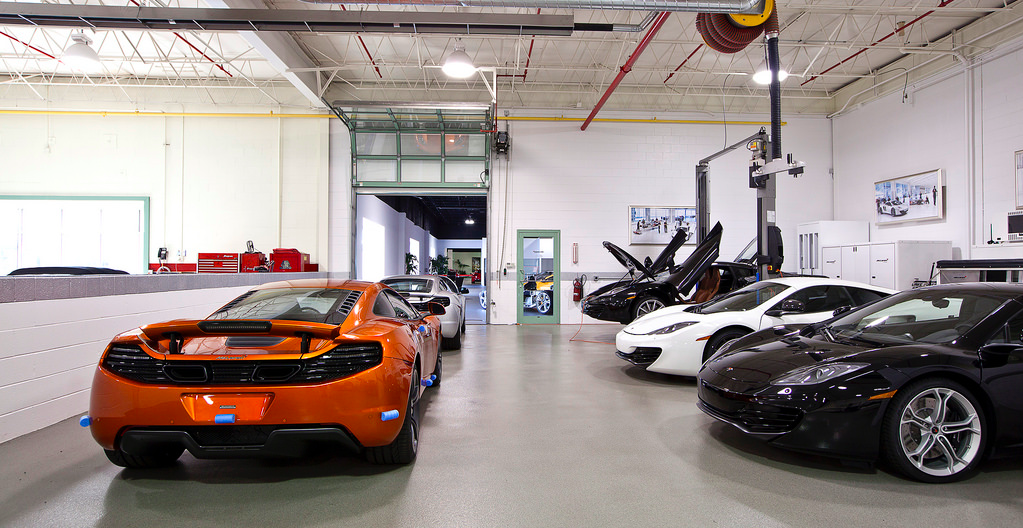 McLaren MP4-12C Common Problems
McLaren MP4-12C Common Problems
With a car so technologically advanced one can expect there to be problems, on top of that the MP4-12C was the first fully McLaren designed car in almost two decades, so there are bound to be some bugs that are needed to be watched out for when deciding to look into it.
- Air bags: Passenger Side Frontal (Recall ID: 17V005000)
This recall effects certain 2012 MP4-12C models that were ever sold in the southern U.S and and Virgin Islands. An inflator was not equipped properly and may result in metal fragments striking the vehicle occupants when deployed which may result in serious inquiry or death.
- Visibility: Windshield/Wiper/Washer:Motor (Recall ID: 13V541000)
This recall effects certain 2012-2014 models sold in the southern U.S. The high temperatures and humidity in these regions may cause the wiper motor to jam and stop the windshield wiper from working resulting in compromised visibility.
- Electronic Malfunctions
Just like nay advanced car, there are always going to be issues with the electronics inside the vehicle, including the climate control LCD, the responsiveness of the touch screen, and poor reception and GPS signal. However, due to McLaren’s awareness, there are always updates for the IRIS system inside he vehicle, so always make sure the software is up to date.
- Door-Opening Mechanism
The small sensor that allows for the doors to open and close is sometimes shorted out in wet conditions not allowing the doors to open at all.
- A/C Radiator
Commonly known to fail and only blast the car with hot air rather than cold.
- Transmission Leakage
One of the worst problems to ever possibly run into has hit the MP4-12C’s before, not in large numbers though. With only a few incidents reported, it is still something worth adding. The transmissions have known to have seals burst and leak oil, when this happens the whole transmission needs to be replaced and that will run you a pretty penny of $28,000.
- Soft Paint
The 2012 models seem to have a weaker paint than the more recent models so be sure to look out for fading or bubbles around curves and corners.
- Shock Leakage
Shocks have been known to leak in the MP4-12C, you would be able to tell because the steering would become rigid and jerky or even at times has moments of stillness.
- Headlight Condensation
Seeming to be a pretty common issue for any MP4 driven excessively in wet conditions.
With the 650S and 675LT still being relatively new models, no recalls have been issues, but both cars have been reported to also have electrical issues that effect everything from radio function to failure to deploy the AirBrake.
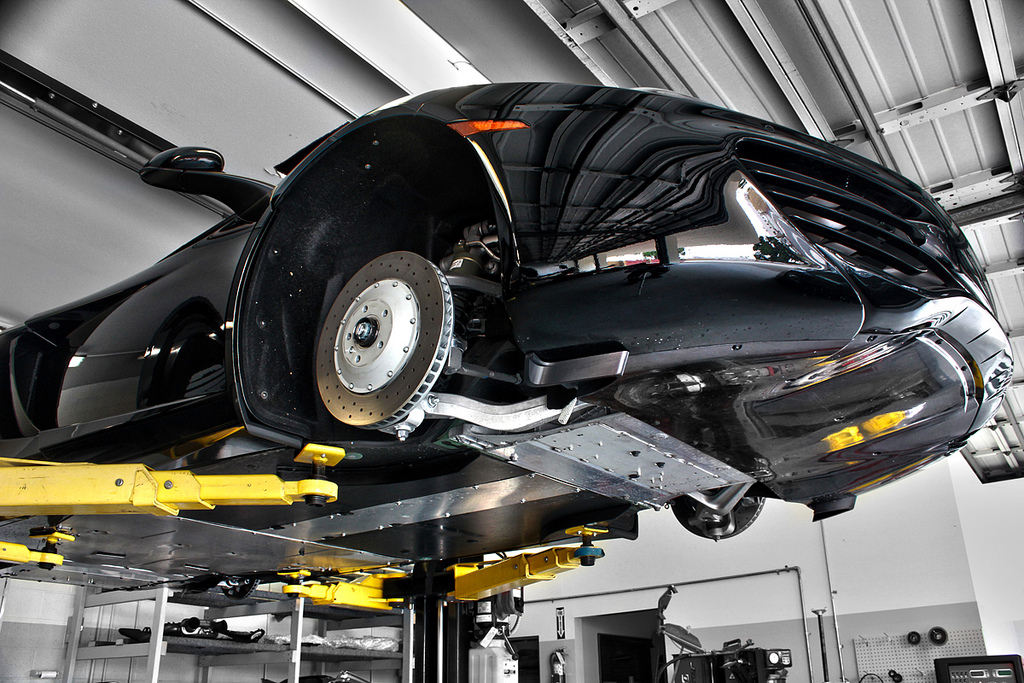 McLaren MP4-12C Cost of Ownership and Maintenance
McLaren MP4-12C Cost of Ownership and Maintenance
Driving such an amazing car does come with a price, more so than just the MSRP, McLaren’s are notorious for being bank breakers when it comes to service and repairs (especially out of warranty). The McLaren MP4-12C and it’s brethren, come with a 3 year/unlimited mile warranty on the vehicle which covers most generic work that needs to be done to the McLaren at anytime, or so one would think. Software updates come with the warranty so your IRIS system is safe for 3 years, after that upgrades are sold to customers at cost which is still $1,800. No joke.
The warranty agreement on the McLaren’s is no laughing matter either, any missed 1yr/10k mile service interval will result in a voided warranty almost automatically. All service work must also be performed by a McLaren dealership at their disclosure of time: taking anywhere up to 6 hours for a simple oil change and inspection to 3 weeks to fly a tech out to look at a broken seal effecting transmission leakage.
The simple service consisting of oil change, windshield wiper replacement, and thorough inspection will cost you upwards of $1,500-$2,000.
Other problems that would be costly outside of warranty are resolving any electrical issues: HVAC display replacement, airbag sensors, door sensors, or even fogging headlight or taillights can be about $2,000. Tires and brakes are no small charge either, tires are going to cost you about $2,000 as well when replacing all four and if you went all in for the carbon ceramic brakes, you’ll dish out about another $2,000 when replacing all four as well.
The warranty can be extended on the McLaren’s, but it isn’t without a price tag, every year you wish to extend the warranty it will cost you $3,500. So the principle of “better safe than sorry” may or may not resinate with you when making this decision.
Now this seems like a lot of dollars to be paying when thinking about service, but the McLaren is truly a supercar in it’s own right. And while these prices seem extreme when put next to a 911 Turbo, remember that you are not driving a 911, you are driving one of the most sophisticated and powerful cars designed for both track and road.
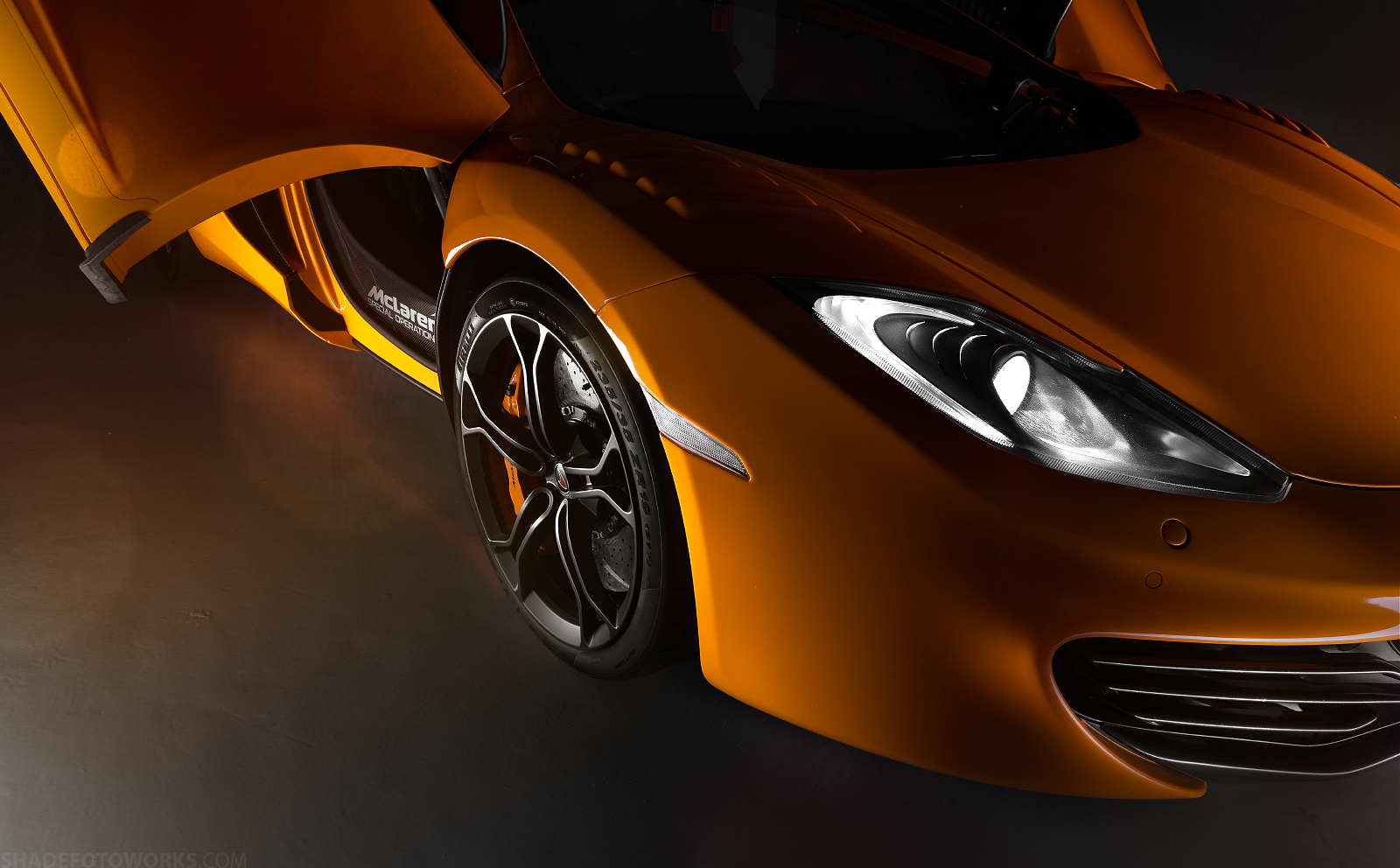 McLaren MP4-12C Model Year Changes
McLaren MP4-12C Model Year Changes
The McLaren MP4-12C was a short lived beast only in production from 2012-2014. Rather than continuously making improvements to a single model, McLaren went ahead and ended production and created new and improved McLaren’s to take it’s place.
The one change that occurred to the McLaren MP4-12C was that the 2013 and 2014 models came with another trim, a spider trim. Identical in every way to its coupe counterpart, the spider is a hardtop rendition that adds a cruiser aspect to the supercar dimension. Hydraulic controls allow for easy and quick open and close and in place of a large back window, there is the storage compartment behind the cabin and before the engine bay cover.
Replacing the MP4-12C in 2015, the 650S came with more than just the exterior changes listed previously (“Thee headlights take on the P1 design of the total speed-mark logo shape. P1 influence is also carried down into the front bumper with fully open frontal bar to give more room for the air intakes, sitting lower than on the MP4-12C. The side air-intakes are no longer the double blade design from the MP4, but are now singles that blend into the body line.”) Not much was changed on the inside either, except giving the option for P1 racing seats. The best parts were saved for the power. While suspension and handling didn’t change all too much from the MP4, McLaren decided to add a few more horses to really see what it’s brain child was capable of doing. Still with the twin turbo 3.8 liter V8 engine, the 650S is tuned to 641 horsepower and makes 500 pounds of torque, all while not compromising fuel economy (16 (city) mpg/22 (highway) mpg). The 650S wasted no time with coming out with it’s Spider counterpart that adds on an extra $15,000 o MSRP, starting production the same year as the coupe.
An upgrade from the 650S, the 675LT packed a punch when it rolled out onto the streets. On top of the exterior modifications (“Coming with an extended wheelbase, the aerodynamics are only further heightened. Anything that can be carbon fiber is now carbon fiber to help reduce weight even more, including everything from the extended front splitter to the extended side air intakes. Perhaps the most noticeable upgrade is the 50% larger carbon fiber AirBrake”). Like the shift from the MP4 to the 650S, the real change is in the power. Tuned to the height of it’s power, the 675 emits 666 horsepower and 516 pounds of torque from the same twin turbo 3.8 liter V8 engine. The 675LT also took the initiative in making the Spider come out along side the coupe at the same time. The interior mirrors the 650S design, complete with the standard P1 racing seats.
McLaren MP4-12C Options
While it is not necessarily a Ferrari and teeming with option lists that could stretch as far as the eye can see. McLaren worries less about personalization and decoration and leveling its options to help optimize power, performance, and some looks at the same time.
Below is a priced-out full option list from McLaren on the 2012 MP4-12C model.
Best Years To Buy The McLaren MP4-12C
Though it was only in production for 3 years, the 2013-2014 models are optimal for purchase with a depreciation curve that is headed in the right direction for buyers in the market for one now. With an IRIS electronic system update coming standard after 2013 to fix bugs from the previous 2012 glitches, there are less technological mix-ups. The 2013-2014 models also give you the option to go for the spider, which would become more optimal for people seeking a more relaxed driving experience without sacrificing the power. While the 650S and 675LT are the “new and improved” renditions of the MP4-12C, they are still relatively new and not yet hitting mass depreciation but that could change now with the newly released 570S and soon to be seen (and excitedly anticipated) 720S.
McLaren’s are something that the supercar world had never seen before and now it is hard to picture a world without them. They have designs paving the way for elevated driving and handling with the Brake Steer/Airbrake. Along with adding subtle but key elements of design and feel that make looking at the beast or looking at others looking at you from behind the wheel, a most memorable experiences. With the brand still relatively new, only being in the modern day supercar market since 2012, they have already redefined what it means to be powerful. So while the experience may not be the cheapest, what are you gonna remember more: a 7 series BMW or a 600 horsepower MP4-12C that is sure to give you way more smiles every mile.

